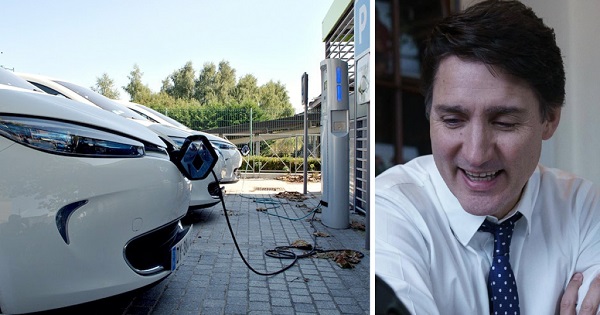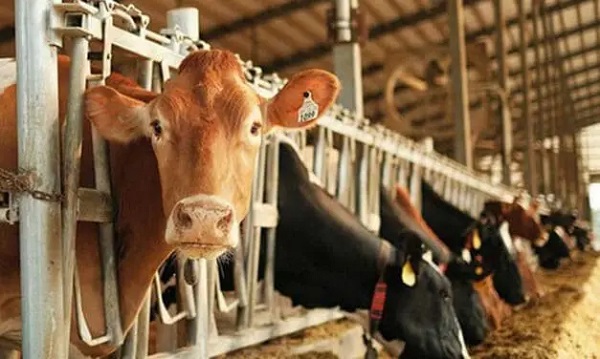Automotive
Trudeau must repeal the EV mandate


Last Monday, Transport Canada released a bombshell statement, announcing that the Trudeau government’s program granting a $5,000 rebate to Canadians purchasing an Electric Vehicle (EV) had run out of money and would be discontinued, “effective immediately.” This followed a prior announcement from the government of Quebec that they would be suspending their own subsidy, which had amounted to $7,000 per EV purchased.
This is, of course, a game changer for an industry which the Trudeau government (as well as the Ford government in Ontario) has invested billions of taxpayer dollars in. That’s because, no matter the country, the EV industry is utterly dependent upon a system of carrots and sticks from the government, in the form of subsidies and mandates.
EVs have remained notably more expensive than traditional Internal Combustion Engine (ICE) vehicles, even with those government incentive programs. Without them the purchase of EVs becomes impossible for all but the wealthiest Canadians.
Which is fine. Let the rich people have their toys, if they want them. Though if they justify the expense by saying that they’re saving the planet by it, I may be tempted to deflate them a bit by pointing out that EVs are in no way appreciably better for the environment than ICE vehicles, how all the lithium, nickel, cobalt, manganese, aluminum, copper, etc, contained in just one single EV battery requires displacing about 500,000 lbs of earth. Mining these materials often takes place in poorer countries with substandard environmental regulations.
Moreover, the weight of those batteries means that EVs burn through tires more quickly than gas-and-diesel driven vehicles, and wear down roads faster as well, which among other issues leads to an increase in particulate matter in the air, what in the old days we referred to as “pollution.”
That is a potential issue, but one that is mitigated by the fact that EVs make up a small minority of cars on the road. Regular people have proved unwilling to drive them, and that will be even more true now that the consumer subsidies have disappeared.
Of course, it will be an issue if the Trudeau Liberals get their way. You see, Electric Vehicles are one of the main arenas in their ongoing battle with reality. And so even with the end of their consumer subsidies, they remain committed to their mandates requiring every new vehicle purchased in Canada to be electric by 2035, now just a decade away!
They’ve done away with the carrots, and they’re hoping to keep this plan moving with sticks alone.
This is, in a word, madness.
As I’ve said before, the Electric Vehicle mandate is a terrible policy, and one which should be repealed immediately. Canada is about the worst place to attempt this particular experiment with social engineering. It is famously cold, and EVs are famously bad in the cold, charging much slower in frigid temperatures and struggling to hold a charge. Which itself is a major issue, because our country is also enormous and spread out, meaning that most Canadians have to do a great deal of driving to get from “Point A” to “Point B.”
Canada is sorely lacking in the infrastructure which would be required to keep EVs on the road. We currently have less than 30,000 public charging stations nationwide, which is more than 400,000 short of Natural Resources Canada’s projection of what we will need to support the mandated total EV transition.
Our electrical grid is already stressed, without the addition of tens of millions of battery powered vehicles being plugged in every night over a very short time. And of course, irony of ironies, this transition is supposed to take place while our activist government is pushing us on to less reliable energy sources, like wind and solar!
Plus, as I’ve pointed out before, the economic case for EVs, such as it was, has been completely upended by the recent U.S. election. Donald Trump’s victory means that our neighbors to the south are in no immediate danger of being forced to ditch gas-and-diesel driven cars. Consequently, the pitch by the Trudeau and Ford governments that Canada was putting itself at the center of an evolving auto market has fallen flat. In reality, they’ve shackled us to a corpse.
So on behalf of my fellow Canadians I say, “Thank you,” to the government for no longer burning our tax dollars on this particular subsidy. But that isn’t even half the battle. It must be followed through with an even bigger next step.
They must repeal the EV mandate.
Dan McTeague is President of Canadians for Affordable Energy.
Automotive
Ford’s EV Fiasco Fallout Hits Hard


From the Daily Caller News Foundation
I’ve written frequently here in recent years about the financial fiasco that has hit Ford Motor Company and other big U.S. carmakers who made the fateful decision to go in whole hog in 2021 to feed at the federal subsidy trough wrought on the U.S. economy by the Joe Biden autopen presidency. It was crony capitalism writ large, federal rent seeking on the grandest scale in U.S. history, and only now are the chickens coming home to roost.
Ford announced on Monday that it will be forced to take $19.5 billion in special charges as its management team embarks on a corporate reorganization in a desperate attempt to unwind the financial carnage caused by its failed strategies and investments in the electric vehicles space since 2022.
Cancelled is the Ford F-150 Lightning, the full-size electric pickup that few could afford and fewer wanted to buy, along with planned introductions of a second pricey pickup and fully electric vans and commercial vehicles. Ford will apparently keep making its costly Mustang Mach-E EV while adjusting the car’s features and price to try to make it more competitive. There will be a shift to making more hybrid models and introducing new lines of cheaper EVs and what the company calls “extended range electric vehicles,” or EREVs, which attach a gas-fueled generator to recharge the EV batteries while the car is being driven.
Dear Readers:
As a nonprofit, we are dependent on the generosity of our readers.
Please consider making a small donation of any amount here.
Thank you!
“The $50k, $60k, $70k EVs just weren’t selling; We’re following customers to where the market is,” Farley said. “We’re going to build up our whole lineup of hybrids. It’s gonna be better for the company’s profitability, shareholders and a lot of new American jobs. These really expensive $70k electric trucks, as much as I love the product, they didn’t make sense. But an EREV that goes 700 miles on a tank of gas, for 90% of the time is all-electric, that EREV is a better solution for a Lightning than the current all-electric Lightning.”
It all makes sense to Mr. Farley, but one wonders how much longer the company’s investors will tolerate his presence atop the corporate management pyramid if the company’s financial fortunes don’t turn around fast.
To Ford’s and Farley’s credit, the company has, unlike some of its competitors (GM, for example), been quite transparent in publicly revealing the massive losses it has accumulated in its EV projects since 2022. The company has reported its EV enterprise as a separate business unit called Model-E on its financial filings, enabling everyone to witness its somewhat amazing escalating EV-related losses since 2022:
• 2022 – Net loss of $2.2 billion
• 2023 – Net loss of $4.7 billion
• 2024 – Net loss of $5.1 billion
Add in the company’s $3.6 billion in losses recorded across the first three quarters of 2025, and you arrive at a total of $15.6 billion net losses on EV-related projects and processes in less than four calendar years. Add to that the financial carnage detailed in Monday’s announcement and the damage from the company’s financial electric boogaloo escalates to well above $30 billion with Q4 2025’s damage still to be added to the total.
Ford and Farley have benefited from the fact that the company’s lineup of gas-and-diesel powered cars have remained strongly profitable, resulting in overall corporate profits each year despite the huge EV-related losses. It is also fair to point out that all car companies were under heavy pressure from the Biden government to either produce battery electric vehicles or be penalized by onerous federal regulations.
Now, with the Trump administration rescinding Biden’s harsh mandates and canceling the absurdly unattainable fleet mileage requirements, Ford and other companies will be free to make cars Americans actually want to buy. Better late than never, as they say, but the financial fallout from it all is likely just beginning to be made public.
- David Blackmon is an energy writer and consultant based in Texas. He spent 40 years in the oil and gas business, where he specialized in public policy and communications.
Automotive
Politicians should be honest about environmental pros and cons of electric vehicles

From the Fraser Institute
By Annika Segelhorst and Elmira Aliakbari
According to Steven Guilbeault, former environment minister under Justin Trudeau and former member of Prime Minister Carney’s cabinet, “Switching to an electric vehicle is one of the most impactful things Canadians can do to help fight climate change.”
And the Carney government has only paused Trudeau’s electric vehicle (EV) sales mandate to conduct a “review” of the policy, despite industry pressure to scrap the policy altogether.
So clearly, according to policymakers in Ottawa, EVs are essentially “zero emission” and thus good for environment.
But is that true?
Clearly, EVs have some environmental advantages over traditional gasoline-powered vehicles. Unlike cars with engines that directly burn fossil fuels, EVs do not produce tailpipe emissions of pollutants such as nitrogen dioxide and carbon monoxide, and do not release greenhouse gases (GHGs) such as carbon dioxide. These benefits are real. But when you consider the entire lifecycle of an EV, the picture becomes much more complicated.
Unlike traditional gasoline-powered vehicles, battery-powered EVs and plug-in hybrids generate most of their GHG emissions before the vehicles roll off the assembly line. Compared with conventional gas-powered cars, EVs typically require more fossil fuel energy to manufacture, largely because to produce EVs batteries, producers require a variety of mined materials including cobalt, graphite, lithium, manganese and nickel, which all take lots of energy to extract and process. Once these raw materials are mined, processed and transported across often vast distances to manufacturing sites, they must be assembled into battery packs. Consequently, the manufacturing process of an EV—from the initial mining of materials to final assembly—produces twice the quantity of GHGs (on average) as the manufacturing process for a comparable gas-powered car.
Once an EV is on the road, its carbon footprint depends on how the electricity used to charge its battery is generated. According to a report from the Canada Energy Regulator (the federal agency responsible for overseeing oil, gas and electric utilities), in British Columbia, Manitoba, Quebec and Ontario, electricity is largely produced from low- or even zero-carbon sources such as hydro, so EVs in these provinces have a low level of “indirect” emissions.
However, in other provinces—particularly Alberta, Saskatchewan and Nova Scotia—electricity generation is more heavily reliant on fossil fuels such as coal and natural gas, so EVs produce much higher indirect emissions. And according to research from the University of Toronto, in coal-dependent U.S. states such as West Virginia, an EV can emit about 6 per cent more GHG emissions over its entire lifetime—from initial mining, manufacturing and charging to eventual disposal—than a gas-powered vehicle of the same size. This means that in regions with especially coal-dependent energy grids, EVs could impose more climate costs than benefits. Put simply, for an EV to help meaningfully reduce emissions while on the road, its electricity must come from low-carbon electricity sources—something that does not happen in certain areas of Canada and the United States.
Finally, even after an EV is off the road, it continues to produce emissions, mainly because of the battery. EV batteries contain components that are energy-intensive to extract but also notoriously challenging to recycle. While EV battery recycling technologies are still emerging, approximately 5 per cent of lithium-ion batteries, which are commonly used in EVs, are actually recycled worldwide. This means that most new EVs feature batteries with no recycled components—further weakening the environmental benefit of EVs.
So what’s the final analysis? The technology continues to evolve and therefore the calculations will continue to change. But right now, while electric vehicles clearly help reduce tailpipe emissions, they’re not necessarily “zero emission” vehicles. And after you consider the full lifecycle—manufacturing, charging, scrapping—a more accurate picture of their environmental impact comes into view.
-

 Business1 day ago
Business1 day agoCanada Hits the Brakes on Population
-

 Crime15 hours ago
Crime15 hours agoBrown University shooter dead of apparent self-inflicted gunshot wound
-

 Crime2 days ago
Crime2 days agoBondi Beach Survivor Says Cops Prevented Her From Fighting Back Against Terrorists
-

 Alberta2 days ago
Alberta2 days agoDanielle Smith slams Skate Canada for stopping events in Alberta over ban on men in women’s sports
-

 Agriculture1 day ago
Agriculture1 day agoWhy is Canada paying for dairy ‘losses’ during a boom?
-

 International2 days ago
International2 days agoHouse Rejects Bipartisan Attempt To Block Trump From Using Military Force Against Venezuela
-

 Automotive2 days ago
Automotive2 days agoFord’s EV Fiasco Fallout Hits Hard
-

 Frontier Centre for Public Policy1 day ago
Frontier Centre for Public Policy1 day agoCanada Lets Child-Porn Offenders Off Easy While Targeting Bible Believers











